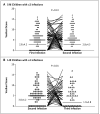Protective effect of natural rotavirus infection in an Indian birth cohort
- PMID: 21793745
- PMCID: PMC3596855
- DOI: 10.1056/NEJMoa1006261
Protective effect of natural rotavirus infection in an Indian birth cohort
Abstract
Background: More than 500,000 deaths are attributed to rotavirus gastroenteritis annually worldwide, with the highest mortality in India. Two successive, naturally occurring rotavirus infections have been shown to confer complete protection against moderate or severe gastroenteritis during subsequent infections in a birth cohort in Mexico. We studied the protective effect of rotavirus infection on subsequent infection and disease in a birth cohort in India (where the efficacy of oral vaccines in general has been lower than expected).
Methods: We recruited children at birth in urban slums in Vellore; they were followed for 3 years after birth, with home visits twice weekly. Stool samples were collected every 2 weeks, as well as on alternate days during diarrheal episodes, and were tested by means of enzyme-linked immunosorbent assay and polymerase-chain-reaction assay. Serum samples were obtained every 6 months and evaluated for seroconversion, defined as an increase in the IgG antibody level by a factor of 4 or in the IgA antibody level by a factor of 3.
Results: Of 452 recruited children, 373 completed 3 years of follow-up. Rotavirus infection generally occurred early in life, with 56% of children infected by 6 months of age. Levels of reinfection were high, with only approximately 30% of all infections identified being primary. Protection against moderate or severe disease increased with the order of infection but was only 79% after three infections. With G1P[8], the most common viral strain, there was no evidence of homotypic protection.
Conclusions: Early infection and frequent reinfection in a locale with high viral diversity resulted in lower protection than has been reported elsewhere, providing a possible explanation why rotavirus vaccines have had lower-than-expected efficacy in Asia and Africa. (Funded by the Wellcome Trust.).
Figures


Comment in
-
Rotavirus infection in an Indian birth cohort.N Engl J Med. 2011 Oct 20;365(16):1548; author reply 1548. doi: 10.1056/NEJMc1109885. N Engl J Med. 2011. PMID: 22010932 No abstract available.
References
-
- Parashar UD, Burton A, Lanata C, et al. Global mortality associated with rotavirus disease among children in 2004. J Infect Dis. 2009;200(Suppl 1):S9–S15. - PubMed
-
- Linhares AC, Velázquez FR, Pérez-Schael I, et al. Efficacy and safety of an oral live attenuated human rotavirus vaccine against rotavirus gastroenteritis during the first 2 years of life in Latin American infants: a randomised, double-blind, placebo-controlled phase III study. Lancet. 2008;371:1181–9. - PubMed
-
- Ruiz-Palacios GM, Pérez-Schael I, Velázquez FR, et al. Safety and efficacy of an attenuated vaccine against severe rotavirus gastroenteritis. N Engl J Med. 2006;354:11–22. - PubMed
-
- Vesikari T, Matson DO, Dennehy P, et al. Safety and efficacy of a pentavalent human-bovine (WC3) reassortant rotavirus vaccine. N Engl J Med. 2006;354:23–33. - PubMed
-
- Meeting of the Immunization Strategic Advisory Group of Experts, April 2009 — conclusions and recommendations. Wkly Epidemiol Rec. 2009;84:220–36. - PubMed
Publication types
MeSH terms
Substances
Grants and funding
LinkOut - more resources
Full Text Sources
Medical
Miscellaneous
